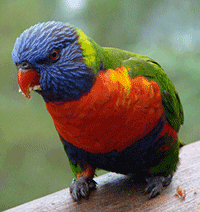
by Jim Hayward
Original homeland
Australia; wide coastal margin spreading from north-east to south-east Australia, and northern Tasmania; range gradually increasing.
Natural habitat
Wooded country, gardens of towns and cities.
Status in the Wild
Plentiful and increasing.
Status in Aviculture
Previous to the wide scale import of species of Indonesian Rainbow Lorikeets it was the commonest lorikeet available; scarcer now and a danger of hybrid Swainson's x Indonesian species causing a drastic depletion of pure stock.
Level of keepers experience
Suitable for beginners with Lorikeets.
Hardiness
One of the hardiest Lorikeets.
Type of Accommodation
A 15ft minimum length by 3ft wide by 6ft high flight with shelter attached; wire flight cages are popular but not the best accommodation for these active swift flying birds.
Type of Diet
A basic diet of Lory nectar (with small pieces of sponge cake or whole meal bread), with a variety of fruit, some greenfood, flowers and blossoms from non-toxic plants and trees as in season, berries as available, and a little seed (some soaked or germinated in spring and summer).
Sexing
Sexes are alike in plumage colouration, nowadays surgical sexing is mostly relied upon.
Sexual Maturity
First breeding attempts as early as two years old.
Nesting season in Britain
Practically any time of year, but - as would be expected - success in rearing young is most likely in the warmer months.
Type of nest
Exterior plywood of 3/4 to 1 inch thick, measuring about 8 inches square inside by 18 inches deep; drainage holes are needed to help prevent youngsters becoming swamped and chilled by their own liquid droppings.
Usual number of eggs
Two, rarely three.
Incubation period
26-28 days.
Usual number of young
Two.
Fledgling age
About eight weeks.
Usual number of clutches
Two per year
Nesting habits
Both sexes roost in the nest, and cocks spend a lot of time in the box while hens are sitting, but only hens actually incubate the eggs. Some nests are extremely messy, while others are inexplicably quite dry.
Special considerations
Large nectar feeding parrots present a lot of cleaning work when housed inside in birdrooms or sheds, and the quick spread of mould over all the surfaces can be an additional problem. An aviary which has a well drained shingle floor and is open to the weather is more desirable. Good hygiene with food dishes and in the aviary is crucial if serious infections are to be avoided. Nectars containing honey and sugar are an attraction for flies, wasps and bees - and in some cases stings have been known to cause the deaths of Lories.
Noise factor
Noisy chatterings are typical and could upset close neighbors.
Availability
In previous years generally available, nowadays becoming scarce.
Colour Varieties
Rare colour varieties have appeared in Australia, including Lutino, Blue and Cinnamon.
